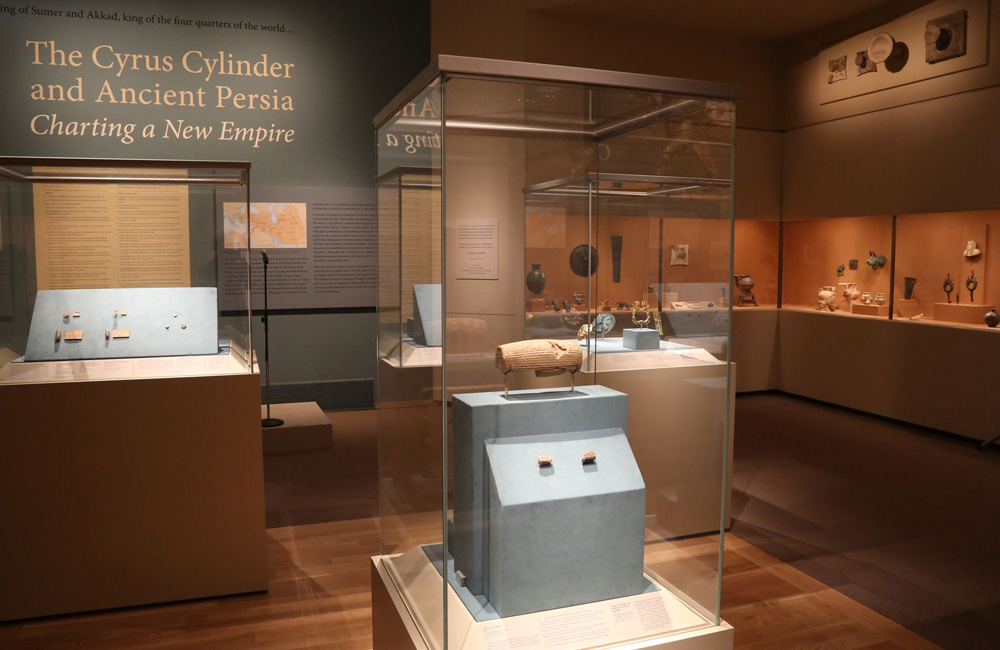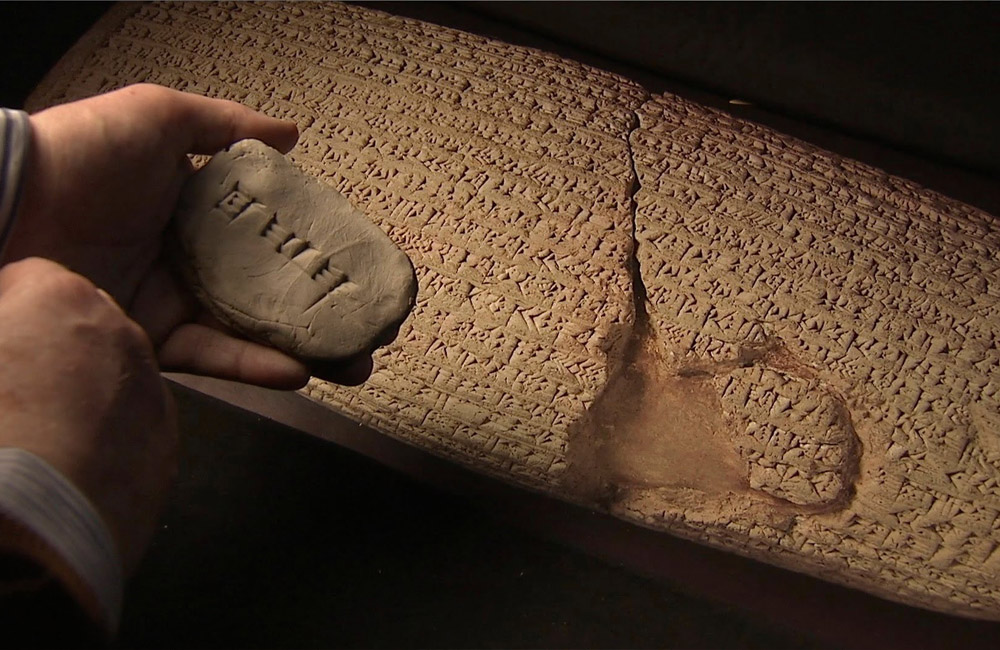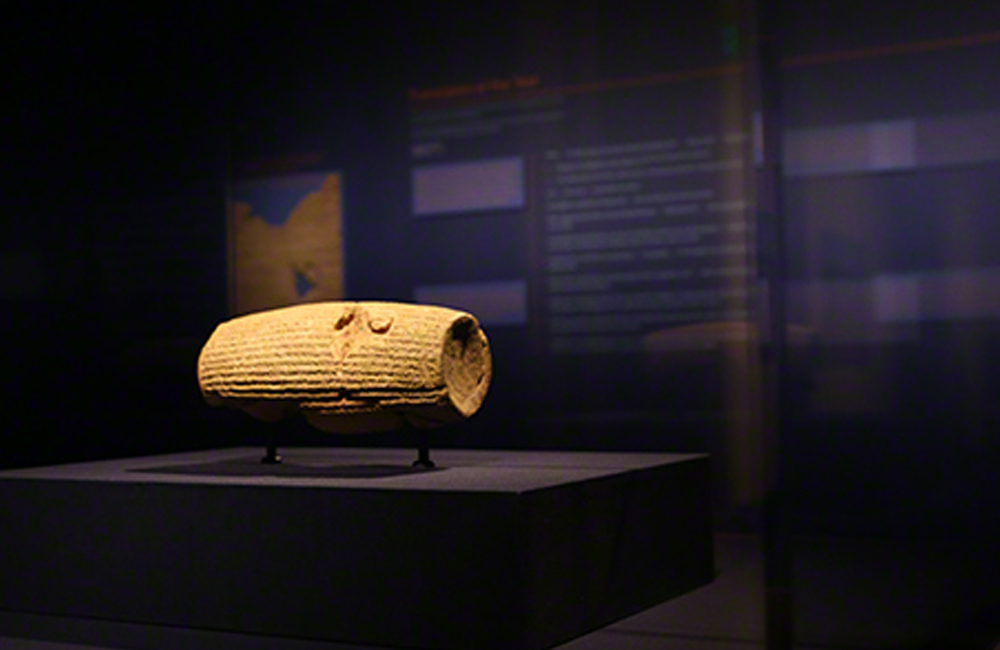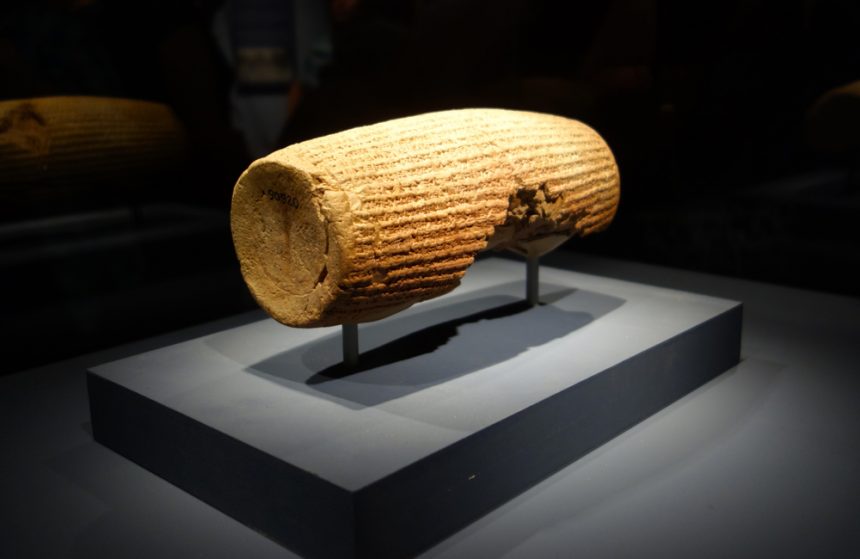One of the most glorious and precious ancient heritages of Iran, is Cyrus Cylinder – Cyrus charter on human rights.
This charter was created 538 B.C. by Cyrus the Great order, who was the king and founder of Achaemenid Empire of Iran (Persia).
Recently, some parts of charter written on two clay plates present in Babylonian collection of Britain Museum is recognized to be a part of this cylinder. The first half of the plate is written by Babylonian historigraphers, and the second part is inscribed by Cyrus the Great in Akkadian cuneiform script. This cylinder was found at 1879 in Marduk Temple in ancient Babylon, preserved in Britain Museum since then. This script exhibits the Persian equanimity spirit. Author of the original charter is unknown, but the author copying the cylinder text is known as Qishty Marduk.

History Behind Cyrus Cylinder
An ancient tradition of Babylonian and Assyrian inscription writing is applied to record this cylinder, mainly includes describing the construction of temples, palaces, forts, waterways and other social services. This has been acted as an opportunity for kings to record their name, characteristics and titles, and to mention the God`s supporting their domination.
Objects of Cyrus Cylinder, holding the inscriptions then was hidden in monuments foundation or inside the walls, with a hope that the next rulers and secretaries will find and recognize these inscriptions, and to respect them. Thus, this inscription is fantasized by pointing at a far past, and by looking at an unknown future, to show an ancient point of view of what we call “history” today.
Since 8th century B.C and during New Babylonian and Assyrian era, royal Babylonian inscriptions used to be created on objects similar to Cyrus clay cylinder. This specific form of inscription was common during New Babylonian era, only used for royal writings, and usually being buried inside the building foundation as a tradition.
Discovering Cyrus the Great Cylinder
During the archeological excavations done by Hormuzd Rassam in March 1879 in Amran hill, Babylon, the cylinder was found. Later, it was found that Esagila temple was buried in northern part of the hill, for that matter the exact location of cylinder in not known. It seems cylinder is found inside a huge wall in south of Amran. The cylinder shape of the inscription along with this information, indicates that the cylinder has been a foundation deposit at that time.
Cyrus Cylinder Appearance
Cyrus Cylinder, is a barrel-shaped clay cylinder contains two parts: the first piece, is the main clay inscription discovered by Hormuzd Rassam, written in 35 lines. The second piece includes 36-45 lines, and is found in Babylonian collection of Yale University by Paul-Richard Berger. Measuring 22.86 centimeters by 11 centimeters, the inscription is written in Akkadian cuneiform (New Babylonian) script. On the barrel-shaped cylinder 45 lines is observed, the first three lines are completely broken, and almost 20 lines are damaged and not available today.

world`s oldest human right charter?
Cyrus Cylinder is considered to be the first charter on human rights according to many scholars. It was translated to six languages at 1971 by United Nation. A copy of Cylinder is kept at United Nations Headquarters in New York City. Britain Museum recognizes this document as the first declaration on human rights. Secretary-General of the United Nations, Ban Ki-moon literally announced Cyrus Cylinder as the world`s oldest human right charter and as an honor for Persians, while travelling to Tehran.

Text
Text consists of stories on conquering Babylon at 539 B.C. by Cyrus the Great, and starts with Marduk (Babylonian God) speech on crimes of Nibonidus, the last Chaldea king. (4-8 lines) (Manshour-e Kourosh)
It continues with explanation of Marduk searching for a merit king, and attributing Cyrus as the ruler of the world, and his peaceful entry to Babylon. (9-19 lines) Then the text switches into the first-person narrative, speaks as voice of Cyrus, addressing his titles (2-22 lines) and announces he has supported the peace in his realm ( 22-26 lines) and for that matter, his son Cambyses and him are blessed by Marduk (26-30 lines). He speaks on temple`s renovation which has been neglected during Nibonidus reign, and declares deported people right for returning back to their homelands. (30-36 lines). Finally, the king explains the building activities and reconstructions in Babylon fort (36-43 lines) and reports finding the inscription of Ashurbanipal within the wall of Babylon. (43-45 lines)
Cyrus Cylinder Text Translation
Line 1: When Marduk, the king of heaven and earth… destroys his enemies… Cyrus, The king of the world, Great King, Powerful king, King of Babylon, King of Sumer and Akkad…
Line 2: The whole world…
Line 3: A low person, put in charge for his country.
Line 4: Destroyed ancient rituals, set counterfeit over them.
Line 5: He made a counterfeit shrine for Esagila and other cities.
Line 6: Impure food offerings…inappropriate rites …daily gabbled.
Line 7: He stopped the daily offering to the Gods. He interfered people`s live with inappropriate rules. He spread the sorrow over the cities. For him, worshipping Marduk, God of Gods, came to end.
Line 8: He made people suffer for livelihood. Distressed the residents every day. He ruined people`s life by his violence….all the people.
Line 9: Enil, became very upset at their complaints, and … their territories. Gods living along with him, left the shrines.
Line 10: People were asking the God almighty to watch all the residents of earth, who`s settlements were going to demolish. Marduk, the great God, decided to bring Gods back to Babylon.
Line 11: Population of Sumer and Akkad have become like corpses. Marduk took pity on them.
Line 12: Marduk started to search all the lands for an upright king, in search of a righteous ruler to help him up. Then he called “Cyrus”, king of Anshan, as the king of world.
Line 13: He made the land of Guti and Median people obedient for Cyrus, while he treated every black headed (human) with justice and righteousness.
Line 14: Cyrus led the country with his justice and integrity. Marduk, the Great God, was pleased by his fine deeds and truthful mind.
Line 15: Marduk ordered that he should go to Babylon, while he was stepping by his side as a true friend.
Line 16: His vast troops, were uncountable like water in the river, were walking by his side fully armed.
Line 17: Marduk had Cyrus enter the Babylon with no war and bloodshed, he saved Babylon from any evil, and handed him Nibonidus.
Line 18: People and governors of Babylon, all the Sumer and Akkad population, bowed down to Cyrus, kissed his feet with their faces glowing by joy.
Line 19: They praised his name, all survived the sorrow and hardship. All the Gods praised his name.
Line 20: I am Cyrus, King of the universe, Great king, powerful king, king of Babylon, King of Sumer and Akkad, King of four quarters of the world.
Line 21: Son of Cambyses, Great king, King of Anshan, Grandson of Cyrus, Great king, King of Anshan, descendent of Teispes, king of the kings.
Line 22: From the everlasting blood of kingdom, who`s reign is praised by Bel and Nabu, asking for his kingdom by their heart, when I entered Babylon in peace.
Line 23: People accepted my steps in joy. I sat on the royal throne in Babylon palaces. I hailed and respected Marduk, thus he set me in pure hearts of Babylonians.
Line 24: My vast troops marched in Babylon peacefully. I did not let any harm and pain distress land of Babylon and people.
Line 25: I tried to improve Babylon condition, Nibonidus had put a yoke on suffered Babylonians that they did not deserved.
Line 26: I removed the yoke and removed all their misery. I let them worship their Gods freely, and ordered no one kills or harms the population of Babylon. Marduk was rejoiced by my good deeds.
Line 27: Over me, Cyrus, who admires him, over my son Cambyses and my troops,
Line 28: Marduk bestowed his mercy and blessing. We all admired his high status, in happiness and peace. By his command, all the kings on their thrones,
Line 29: And all the kings from the Upper Sea (Mediterranean Sea) to the Lower sea (Persian Gulf), all the population of remote lands, all the governors and people who are living in tents,
Line 30: Brought their tribute to Babylon and kissed my feet. From…Ashur and Susa…
Line 31: I rebuilt the dilapidated cities of Akkad, Eshnunna, Zamban, Meturnu, Der, and ancient cities destroyed on the boarder on Tigris River.
Line 32: I commanded to reopen all the shrines, brought back the Gods to their own position, and resettled wandering population. I reclaim all the desolate habitats, call people for integrity.
Line 33: And the gods of Sumer and Akkad – which was taken to Babylon by Nibonidus, with no fear of God, for pleasing Marduk,
Line 34: I returned them safely to their shrines, may all the hearts fill with joy; Gods I brought back to their sacred places,
Line 35: Pray for my long living, every day, in presence of god Almighty. May they bring me blessed and righteous words, and say this to Marduk, my lord: “Endow the highest position of the universe to Cyrus – king that praises you- and his son, Cambyses”
Line 36: No doubt that people call blessing for my kingship in such prosperous days, and I provided a peaceful society for people…
Line 37: Geese, two ducks, ten pigeon, for geese, ducks and pigeons…
Line 38: I strengthen the wall Imgur-Enlil, the great wall of Babylon…
Line 39: And the baked bricked wall on the moat of city…
Line 40: Which has never accomplished during any of previous king`s reign by forcing the slaves
Line 41: I completed the work…
Line 42: Great gates of cedar wood with bronze cladding…
Line 43: An inscription from a king who preceded me, Ashurbanipal…
Line 44: …..
Line 45: …Forever
A Short History on Cyrus Cylinder Translation
After discovering the cylinder and carrying it out to Britain Museum, for the first time in 1880 Theophilus Pinches duplicated the text and recognized this cylinder belongs to Achaemenid king Cyrus the Great, written in Akkadian cuneiform script, describing Persian conquest Babylon. Later on, based on his duplication, Sir Henri Rawlinson translated Cyrus Cylinder text into English for the first time and published it in Journal of Royal Asiatic Society.
In Iran, the text was primarily translated into Farsi by Abdul Majid Arfaei Iranian researcher and Elamitologist. Recently, a new translation by Shahrokh Razmjoo is published based on new findings.
Recommended Reads | Tomb Of Cyrus Pasargadae Shiraz
Recommended Reads | Credit Card in Iran (Tourist Card)


